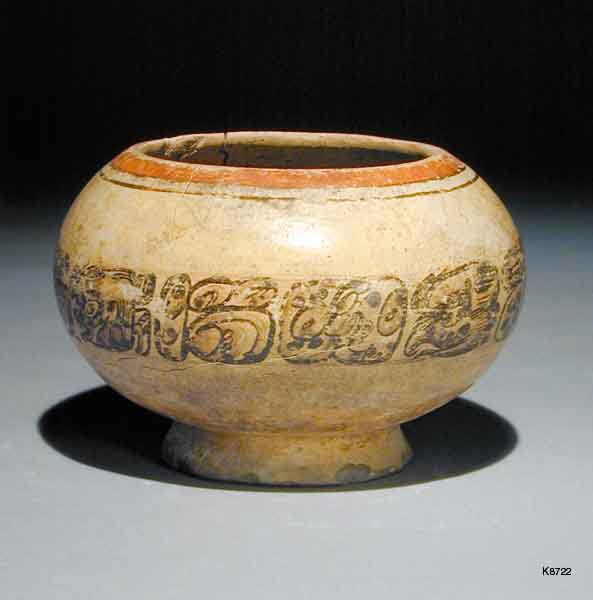Mayavase.com Research Material

Click Here for a larger image of the text

The strange structure and syntax of the PSS on Kerr 8722 can be compared to the strange structure and syntax of Kerr No. 4030 (the only other "strange" PSS within a close to 500 PSS database) Click here for the text of K4030
From Marc Zender
I was surprised and delighted to discover that K5646 actually provides a phonetic complement (-'o) for the last part of the name of this Hix Witz king. Normally, we'd read this glyph as MUWAHN or even CH'EEN, but the complement leaves little doubt that 'O' was intended, the name of a type of hawk according to Wastek and Tojolab'al sources.
From David Stuart
I couldn't help but notice that the name of the Hixwitz lord on these vessels (1387 and 8722) is being read as "Janahb' Ti' Ch'een," but I have to disagree. The final bird head is not the CH'EEN head variant: it lacks all if the diagnostic features, including the tell-tale tri-foil element over the eye. It is more likely to be the "o" bird often seen in the Tonina EG, among other places. I've long thought that this might carry the logographic value O' in addition to syllabic o, since o' or o'o is an attested word for a raptorial bird in Classic Yucatec, cited in the Ritual of the Bacabs. At least it has to work as a logogram in some settings, as here in the name and also in the proper name of a building cited in the dedication phrases from Temples XIX and XXI at Palenque (K'INICH-O'?-NAAH). I realize that some of these bird signs look pretty similar, including the possible b'e syllable.Anyway, it is interesting to see that the same name also appears at Seibal, Panel 7 (I think) written ja-na-b'i TI'-O'?, and naming a local ch'ok ajaw -- clearly not the same guy.
Dave's certainly right about the O' value for the bird head. In fact, as I'd pointed out to Justin on friday, there's a lovely piece of evidence in favor of just this contention on another Hiix Witz vessel, K5646 Here, the same name appears once again (Janaab' Ti' O'), though this time with a final -o phonetic complement (the more typical "feather" o, itself probably derived in pars pro toto fashion from this same bird head) -- strong evidence indeed that we're dealing with a logograph..
In addition to the Classical Yucatec sources Dave mentioned, I've also seen evidence for 'oo in Huastec, though here it more specifically means "gavilán". Could the term have been synonymous with better-known Muwaan? If so, it may be telling that Muwaan has calendrical connotations and that O' seemingly does not -- much like Hiix and B'ahlam, for instance, or Ook and Tz'i'. As Campbell has elsewhere argued, such domain-specific contexts may motivate the adoption and/ or invention of synonyms in Mayan languages.

